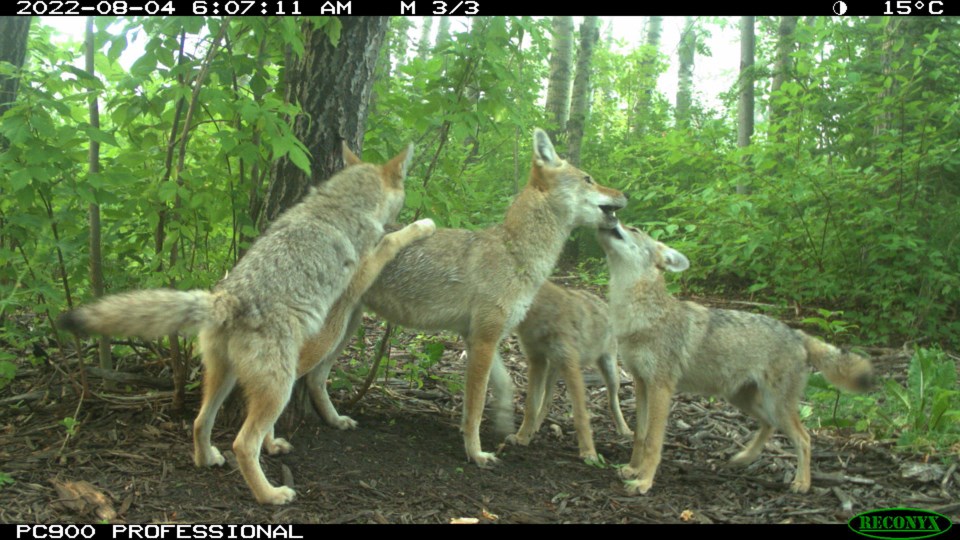Revered in Indigenous cultures and creation storytelling, reviled and misunderstood by settlers and ranchers, the coyote is the most persecuted carnivore in North America.
And to hear Dr. Shelley Alexander tell the story, it may be the most interesting as well.
Alexander has been working on a coyote co-existence plan for the University of Calgary since 2018.
At her presentation in Cochrane Saturday Alexander’s fondness for the animals she specializes in researching shines through the data from time to time as she does a pretty convincing impersonation of what a coyote will look like if they are genuinely aggressive, and how amused she was to discover an intact stuffy she had left near a den five months earlier, indicating the pups must’ve seen the value in protecting the toy instead of tearing it apart like a domestic dog would have done.
These “highly curious, often adventurous” predators predate the arrival of humans in North America by thousands of years and are expert adapters, thanks to complex socialization mechanisms and impressive intelligence.
Coyotes howling at night usually is a way for them to see how many of their kind are nearby, Alexander said.
“They’re calling out to see who’s around – ‘Hey, anybody out there’?”
The information may be helpful during the time of year known as dispersal (October to December), when they consider possible territorial movements. One of the ways coyotes regulate themselves is by knowing population densities.
Their intricate vocalizations and other play behaviours also help them navigate what Alexander called codes of justice and morality.
Learning the rules of play helps them understand the world and may also help to understand human socialization.
Their offspring are raised using “alloparenting” – a term for any form of parental care provided by an individual towards young that are not its own direct offspring. After the initial five weeks of care, when it’s time for mom to take a break, the rest of the family (siblings, fathers, cousins, grandparents) take over in shifts.
“The pups treat the babysitter differently, just like when mom and dad go out and human kids get on the babysitter – the rules change,” she said.
Rule breakers can get kicked out, which may have an effect on odds for survival.
Coyotes adapt their diets easily, can live in solitary pairs or larger families depending on what’s there for food.
Under the ‘Fun Facts’ heading, Alexander cited one study documenting badgers and coyotes living together in a mutually beneficial arrangement where co-operative hunting behaviours were the norm.
The video shows coyotes and badgers playing and running together, and the research showed how both species had a better life expectancy because they worked together.
Adaptability and intelligence are the keys to longer life expectancy.
Approximately 200 years of killing coyotes has not worked to reduce conflict with humans. The science shows killing actually can make things worse.
Alexander said research shows that the random killing of an adult may have unintended consequences, since the younger animals still in the area may have a harder time learning to adapt and survive, which in turn may lead to increased conflict with humans.
“The knowledge keepers are removed and you have a younger population,” she said.
She cited statistics showing coyotes are a low risk for conflicts with humans.
Much of the fear of coyotes stems from misunderstandings, she said, including media sensationalism of encounters.
“Conflict is predictable and preventable,” she said.
In cases of dogs being attacked by coyotes in Canada, 92.3 per cent of the time the dogs were off leash.
Fewer than three (2.67) Canadians were bitten or scratched last year, and 100 per cent of coyote attacks on humans were related to people trying to feed them.
So Alexander’s advice to improve those odds were:
Keep attractants to a minimum – bird seed, garbage, compost, pet food, etc. (She showed a slide of a coyote that had figured out how to get right up into the boughs of a crab apple tree).
Never feed a coyote; always maintain distance from them; keep all pets leashed (coyotes see dogs as threats); do not allow pets to approach coyotes, pups, or dens; put garbage in properly marked bins, and admire them from afar.
When encountering a coyote: remain calm; do not scream, run or turn your back; pick up small children and pets, bring leashed dogs to your side, and walk away from the coyote.
And her last section of advice is for when the coyote still approaches after following the previous points: consider you may be between the coyote and its pups or food; confirm the coyote can get around or away from you; be big and loud (clap hands, put arms above head and yell, or pop an umbrella or snap a large plastic bag, and, walk away.
Alexander said the presence of a moose in the area doesn't mean Cochrane residents can expect an uptick in coyote sightings, since they hunt much smaller game like squirrels and rabbits. Even their larger cousin the wolf will rarely take on a moose. A wolf pack would likely come away from an encounter with more damage than they inflict.




